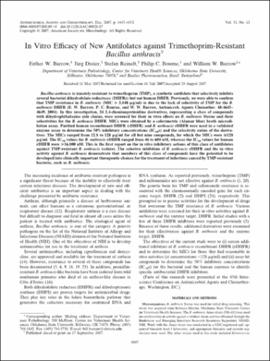| dc.contributor.author | Barrow, Esther W. | |
| dc.contributor.author | Dreier, Jurg | |
| dc.contributor.author | Reinelt, Stefan | |
| dc.contributor.author | Bourne, Philip C. | |
| dc.contributor.author | Barrow, William W. | |
| dc.date.accessioned | 2018-08-17T16:24:46Z | |
| dc.date.available | 2018-08-17T16:24:46Z | |
| dc.date.issued | 2007-12 | |
| dc.identifier | oksd_barrow_invitroefficacy_2007 | |
| dc.identifier.citation | Barrow, E. W., Dreier, J., Reinelt, S., Bourne, P. C., & Barrow, W. W. (2007). In vitro efficacy of new antifolates against trimethoprim-resistant Bacillus anthracis. Antimicrobial Agents and Chemotherapy, 51(12), 4447-4452. https://doi.org/10.1128/AAC.00628-07 | |
| dc.identifier.uri | https://hdl.handle.net/11244/301424 | |
| dc.description.abstract | Bacillus anthracis is innately resistant to trimethoprim (TMP), a synthetic antifolate that selectively inhibits several bacterial dihydrofolate reductases (DHFRs) but not human DHFR. Previously, we were able to confirm that TMP resistance in B. anthracis (MIC > 2,048 ug/ml) is due to the lack of selectivity of TMP for the B. anthracis DHFR (E. W. Barrow, P. C. Bourne, and W. W. Barrow, Antimicrob. Agents Chemother. 48:4643-4649, 2004). In this investigation, 24 2,4-diaminopyrimidine derivatives, representing a class of compounds with dihydrophthalazine side chains, were screened for their in vitro effects on B. anthracis Sterne and their selectivities for the B. anthracis DHFR. MICs were obtained by a colorimetric (Alamar blue) broth microdilution assay. Purified human recombinant DHFR (rDHFR) and B. anthracis rDHFR were used in a validated enzyme assay to determine the 50% inhibitory concentrations (IC50s) and the selectivity ratios of the derivatives. The MICs ranged from 12.8 to 128 ug/ml for all but nine compounds, for which the MICs were >/= 128 ug/ml. The IC50 values for B. anthracis rDHFR ranged from 46 to 600 nM, whereas the IC50 values for human rDHFR were >16,000 nM. This is the first report on the in vitro inhibitory actions of this class of antifolates against TMP-resistant B. anthracis isolates. The selective inhibition of B. anthracis rDHFR and the in vitro activity against B. anthracis demonstrate that members of this class of compounds have the potential to be developed into clinically important therapeutic choices for the treatment of infections caused by TMP-resistant bacteria, such as B. anthracis. | |
| dc.format | application/pdf | |
| dc.language | en_US | |
| dc.publisher | American Society for Microbiology | |
| dc.rights | This material has been previously published. In the Oklahoma State University Library's institutional repository this version is made available through the open access principles and the terms of agreement/consent between the author(s) and the publisher. The permission policy on the use, reproduction or distribution of the material falls under fair use for educational, scholarship, and research purposes. Contact Digital Resources and Discovery Services at lib-dls@okstate.edu or 405-744-9161 for further information. | |
| dc.title | In vitro efficacy of new antifolates against trimethoprim-resistant Bacillus anthracis | |
| osu.filename | oksd_barrow_invitroefficacy_2007.pdf | |
| dc.description.peerreview | Peer reviewed | |
| dc.identifier.doi | 10.1128/AAC.00628-07 | |
| dc.description.department | Veterinary Pathobiology | |
| dc.type.genre | Article | |
| dc.type.material | Text | |
| dc.subject.keywords | antiinfectious | |
| dc.subject.keywords | antibacterial agent | |
| dc.subject.keywords | bacillus anthracis | |
| dc.subject.keywords | resistance | |
| dc.subject.keywords | trimethoprim | |
| dc.subject.keywords | antifolate | |
| dc.subject.keywords | treatment efficiency | |
| dc.subject.keywords | in vitro | |
| dc.subject.keywords | pyrimidine derivatives | |
| dc.subject.keywords | bacteria | |
| dc.subject.keywords | bacillales | |
| dc.subject.keywords | bacillaceae | |
